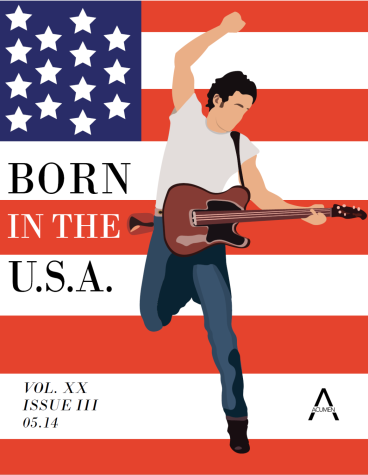Uniting Events
In recent years, there have been many events that have created unification for the U.S, but also developed underlying themes of division as well. One of these events, COVID-19, has been extraordinary for people born after the 9/11 crisis, since this is their first major global crisis of their lifetime that they can recall and have lived through. For junior Yianni Paikos, he said unification and division is a common theme in history.
“There really is no in-between,” Paikos said. “Society is usually either divided or unified. We see division, for example, during elections when different political views are expressed or when people hold different views on social norms.”
He said the most recent example of social division was the COVID-19 pandemic.
“The pandemic for sure caused division,” he said. “This is especially seen with the differing opinions on government mandates and policies. I remember there was a big problem with people wearing or not wearing masks, or people who supported vaccinations and people who didn’t.”
Junior Caleb Kim said division also occurred from the racist sentiments that came with the pandemic.
“An obvious effect of the pandemic was the increase in racism towards Asians,” he said. “A lot of people blamed Asians for the outbreak of the pandemic and continued to put blame on them as the illness spread. Asian hate really became a more heightened issue.”
However, COVID-19 is only one of the many events that have taken place which created division. In the case of history teacher Allison Hargrove, 9/11 was a major event which created both unification but ultimately division in the U.S.
“In my lifetime, the most obvious example would be Sept. 11, 2001,” she said. “I think that as an AP U.S. History teacher, one of the things that I have the ability to understand is that there are moments in history that collectivized groups in society. This certainly occurred on 9/11. Despite all of the political divisions that existed prior to that day, this was something where the nation came together, mourned together and grieved together.

She said 9/11 brought many Americans together in the midst of the crisis.
“I always talk in my AP U.S History class about the period after 9/11 where there was a concern about France and their (lack of) support during the crisis,” she said. “So instead, when people would go out and order french fries, they would ask for “freedom fries”. So it created a sense of depending on ourselves, that we are united in this fight, but at the same time it put us against the world. There was a sense of us versus everybody else.”
However, during this moment of unification, Hargrove said divisions within the U.S began to occur.
“Within the country of course, internal divisions developed,” she said. “People supporting the global efforts, people who didn’t support the global efforts. But also people who start becoming concerned about radicalized groups and what that could lead to at home. We look at minority groups, specifically Muslims, and how they became targeted because of the actions of a radical few.”
According to Paikos, the COVID-19 pandemic is significant because of how recently it took place.
“COVID-19 is important because it happened in our lifetime or our generation,” he said. “You look at other events in the past like 9/11 which created unification or division, and you can’t really relate to it because obviously we weren’t alive then. But COVID-19 is something we still remember really well.”
Kim said 9/11 and COVID-19 are similar in some ways.
“Although the actual events that happened were very different, one being a terrorist attack and the other being an illness, some of the effects were similar,” he said. “For example, the government played a really big role in both events. For 9/11, airport security became more strict and during the pandemic, the vaccine and mask mandates were passed by the government. There were of course some similarities in which minorities were discriminated against, with Muslims being the main target during 9/11 and Asians being a target during the pandemic.”
Paikos said the pandemic created unity as well, even in the midst of division.
“The pandemic brought a lot of people together in different ways,” he said. “Look at Zoom for example. People needed ways to communicate outside of meetings face to face. This encouraged people to devise new ways of communicating or better means of communication. People had to work together and improvise. And I think this changed society in a positive way.”
Hargrove said she agreed with Paikos. She said unification was a big theme during the crisis.
“(COVID-19) did create unity,” she said. “I think especially at the beginning when people were so scared and during lockdown when most people were willing to do that initially. It created a sense of unity, that we’re in this together and how we’re fighting against a common enemy, which in this case was an illness.” However, she also emphasized the long term divisions that occurred from the pandemic.
“I think though, after the first wave and the lockdown, people started to challenge the information that was being given and started to really question the methodologies that the government were using,” Hargrove said. “People were scared so they trusted the scientists and when things didn’t exactly turn out as initially anticipated, people started to scatter and all sorts of conspiracy theories emerged. Many people clung to the science and the government response while others resented it. And so there was an initial sense of unity that we saw, but at the same time it created a deeper sense of distrust for the government to some people.”
Paikos said major events always have negative and positive consequences. However, he said it’s important to understand historical events in an objective way.
“Many crises in history are similar to a coin, where there’s a heads and tails,” Paikos said. “There are both sides to them, whether they are positive or negative, or cause unity or division. What I think is important though, is to analyze the event objectively and see the negatives or positives without bias. If you look at history this way, things become more clear and you get a better understanding of what really happened.”





